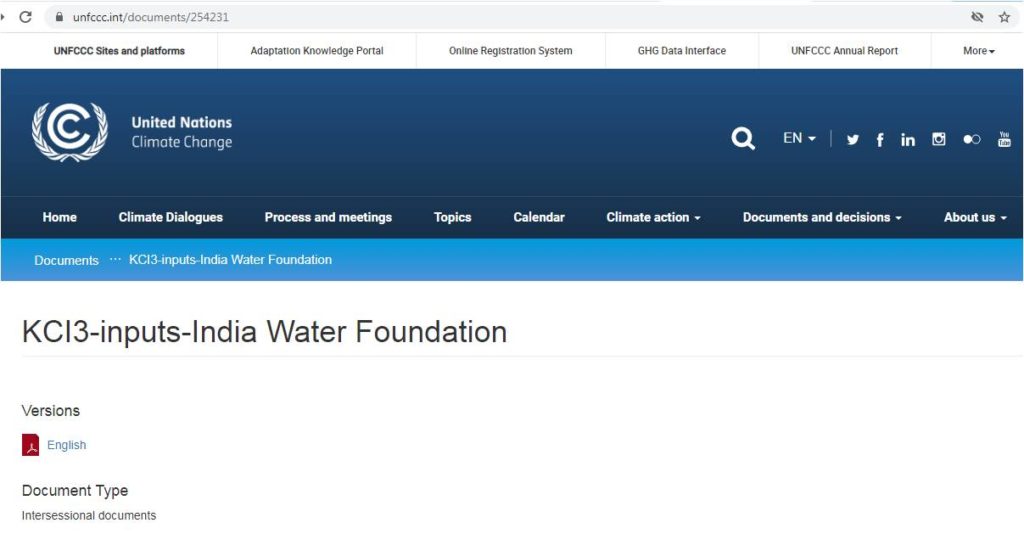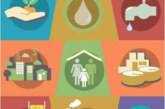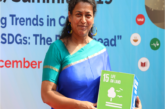Summary of Takeaways to be incorporated within the framework of climate change

The need for vigorous incorporation of interactions and joint implementation of the Paris Agreement and Agenda 2030 calls to disrupt sectoral thinking and subsequently make a decisive contribution in terms of driving sustainable development owing to the complementary nature of the measures. Facilitating implementation of transversal approach warrants smarter decision-making based on the best knowledge and practices available and commitment to action with other sectors through working partnerships and shared responsibilities towards realizing holistic climate change agenda.
Key Insight 1
Realization of various goals and targets of UNFCCC, there is growing need for moving beyond top-down approach and foster local level governance. A need is emphasized to enhance engagement with stakeholders, including local community, public/private sector industry, civil society with knowledge-driven actions required to accelerate climate resilience on the ground. These partnerships, which complement government action, allow communities to access new knowledge, expertise, financing and resources that are often critical to advancing its work and help it to leverage skills, expertise and other resources that will support and advance its mandate of delivering grass root results. It is imperative to reflect on how societies can be made more resilient while confronting climate challenges, because transitioning towards more sustainable and resilient societies also requires an integrated approach that recognizes that environmental challenges and their solutions are interrelated.
Key Insight 2
Women’s contribution to sustainable development must be recognized because their knowledge, science, and skills are critical for the sustainable preservation of biodiversity, regard to the use and protection of natural resources and understanding various climate change issues. Gender based agenda should serve as a foundation stone towards advocacy, knowledge deepening, policy analysis, integration of environment and social sustainability and strengthening participatory governance of women alongside men in an integrated way. They have an inherent ability to promote transformative partnerships that help to adapt to the effects of climate change and build resilient societies. More should be done to increase women’s voice in environmental decision making and enable women to seize opportunities in the “green economy” and advance socio-economic adaptation measures.
Key Insight 3
Strengthening actions for nature to achieve sustainable development goals is a commitment to work with nature and re-naturing human civilization. Achieving SDGs with climate goals shall include symbiotic implementation of Nature based Solutions like Eco-system based adaptation, water-food-energy nexus, ecosystem governance, Eco-disaster risk reduction, cultural-traditional practices, nature based adaptation & mitigation management along with science based solutions towards resilience, shared prosperity and well being. Demonstration that supplementing Integrated Water Resource Management with water-energy-food nexus approach and Ecosystem based Adaptation is helpful in effectively addressing water and climate change related vagaries. Water is a cross-cutting issue both within and beyond the scope of Agenda 2030. This calls for according priority to the fundamental role of interactions at inter-sectoral level in the implementation of climate-related goals at /national/state/local level and to ensure that measures under the Paris Agreement and Agenda 2030 are implemented in a coherent and complementary manner by every country. There is need for vigorous incorporation of interactions and joint implementation of the Paris Agreement and Agenda 2030, which shall disrupt sectoral thinking and subsequently make a decisive contribution in terms of driving sustainable development owing to the complementary nature of the measures. Facilitating implementation of this approach warrants smarter decision-making based on the best knowledge available, and commitment to action with other sectors through working partnerships and shared responsibilities under the broad framework of UNFCCC.
Now that the ‘Ecosystem Restoration’ has heightened our race to fight against the impacts of climate change and biodiversity loss, it has become imperative that UNFCCC framework systematically integrates climate restoration strategies through multi-stakeholder partnership, with fast paced efforts especially in developing and least developing countries where cooperation is less and much difficult to attain a common consensus.
Key Insight 4
Role of civil society assumes added significance in the wake of Agenda 2030, SDGs and Paris Agreement on Climate Change to bring about grass root activism. While helping the national governments in integrating the salient features of the international agreements on water, environment, climate change and other related development issues into policies and actions, civil society also helps in building the capacities of the people, especially the local populace at the grassroots levels in these issues.
Communities are inadequately empowered through capacity building and extensive Information, Education and Communication (IEC) activities and should be gradually groomed to plan and manage various targeted activities. This task of capacity building can better be facilitated through the civil society because given the large user population it is almost impossible for the government agencies to reach out to them. Undoubtedly, the government with its large paraphernalia is well equipped in fiscal and technical resources, but it is incapable of building the capacities of the people in water, climate change and other related SDGs for want of resource persons. On the other hand, civil society has trained personnel, who are expert and well-versed in imparting training to the people, who are the ultimate stakeholders, by building their capacities in respective fields. Thus, it devolves on the UNFCCC stakeholders, respective stakeholder countries and governments, parties to UNFCCC to encourage the role of the civil society in their respective countries to help implement the climate action goals and usher in a secure future for the posterity.
Key Insight 5
A successful climate adaptation agenda requires inclusive partnerships at the global, regional, national and local levels that are built upon principles and values, and upon shared vision goals placing people and the planet at the center. Identification of prevailing forces and conditions that serve as barriers to action or enabling factors in the implementation of climate change adaptation measures shall be undertaken. This is necessary to understand challenges viz social-economic, techno-cultural which inhibit enhancing the capabilities of communities to participation in climate-related decision-making and processes in tandem with their felt-needs and priorities. Assess the adaptation measures that poor and marginalised people already take and relate this to their resilience to withstand climate-induced vulnerabilities; identify the wider vulnerabilities people face and to the dynamics of their livelihoods and their assets base, with particular attention to environmental resources and assess the adaptation measures that poor people already take and relate this to their resilience to withstand climate-induced vulnerabilities.
Approaches and Activities to facilitate UNFCCC actions and goals:
India Water Foundation (IWF), established in 2008 as a non-profit civil society & think tank, is engaged in familiarizing people regarding the vital role water, energy and environment play in human lives, their impact on health, economic growth, livelihoods and calamities that wreak havoc due to non-judicious harnessing of these natural resources in Asia-Pacific region in general and India in particular. The trajectories based on ‘sectoral or silo approach’ have failed to attain the goal of sustainable development and climate related goals for want of capacity building of the stakeholders, convergence, cooperation and coordination between actors and various sector.
Since 2012, India Water Foundation played a pivotal role as ‘development partners’ with Meghalaya Basin Development Authority, Government of Meghalaya and instrumental in evolving Meghalaya model of development and natural resources convergence to foster relations among Centre, States, UN and other international agencies to help development of water conservation, agriculture, forestry, skill development etc. The basic strategies revolved around strengthening community empowerment through an area wise (basin) approach rather than department centric approach.
Background
The Indo-Malayan realm of South-East Asia contributes many of the tropical taxanomic biodiversity. In addition, climatic variability, a result of complex and steep topography across the north-south axis of the Himalayan range, leads to heterogeneity, diverse habitats, and ecosystems that enrich the region with biodiversity across a vast landscape.
Meghalaya, a North-East state of India is rich in important minerals such as coal, limestone, large forest cover, soil biodiversity rich flora & fauna and blessed with abundant water bodies but possess a fragile eco-system. Being a part of humid sub-tropical climate zone, recorded vast amounts of methane with heating potential higher than carbon dioxide were released However, Geogenic events and anthropogenic practices due to unsustainable agricultural practices or non-scientific mining has affected soil and water quality, making it acidic resulting in environmental degradation. Practices like deforestation, traditional jhum (slash and burn) cultivation etc. drastically affected hydrological parameters, viz. rainfall interception, infiltration, soil moisture, water yield, soil loss, floods, etc. At the same time, swamps, marshes, and other wetlands are increasingly being reclaimed for urban and agricultural expansion. Mining also added dust to the air through fugitive emission leading to health hazards of the local inhabitants and contributed to air pollution of more that 50% through SPM, SOX and NOX emission. Since the tribal hunter-communities, pursued hunting of avian and aquatic population for food and livelihood; this led to biodiversity loss on a large scale. Direct N2O emissions were produced as part of the Nitrogen cycle through the nitrification and de-nitrification of the organic Nitrogen in livestock dung, agricultural fertilisers and waste discharges and excessive nutrient eutrophication in water bodies. The case studies also outlines gender issues and provide evidence of the importance of women’s participation for effective and sustainable biodiversity conservation and management in the Eastern Himalayan region. Uniqueness of this solution from other approaches lies in its being all-inclusive, comprehensive, gender-specific and cost-effective. Women in mountain communities directly depend on natural resources to meet their environmental, nutritional, and socio-cultural needs and those of their families and communities.
Approach
IWF essentially emphasized community dialogue along with the role of natural ecosystems, biodiversity and ecosystem services in underpinning sustainable development and ensure that the twin goal of natural resource management and livelihoods are simultaneously integrated in every biodiversity action plan
Water Mission was launched by Government of Meghalaya as part of its flagship initiative Integrated Basin Development and Livelihood Programme (IBDLP) initiated in 2012 with the objective of promoting Integrated Water Resources Management (IWRM) in the State and to conserve and use water judiciously. Growing international recognition that IWRM alone wouldn’t be sufficient to combat environment-induced and water-induced vagaries, that water is key to sustainable development, that water, energy and food are inter-connected and interdependent and that water is at the core of climate change proved instrumental in shifting focus from IWRM to water-energy-food nexus approach and ecosystem-based adaptation (EbA) approach for judicious water governance and climate resilience.
Mission Green was a key intervention strategy implemented in all the 39 Blocks of the state towards sustainable development and natural resource management (NRM) with focus on Greening Catchment Areas; Promoting Clean/Green Villages; Water Management; and Green technologies. In brief, the Mission Green initiative is to promote protection of catchments forests and create awareness about the need to conserve natural resources through behavioural change. It intends to do so by empowering village communities to sustain the soil cover and greenery required for protection and conservation of water and land resources while at the same time creating opportunities to address basic and livelihood needs. Under Forestry and Plantations mission, IWF cooperated with concerned departments in facilitating integrated and multidisciplinary participatory planning and formulation of schemes etc and local communities were also provided training in seeking alternative sources of energy to reduce pressure on the existing forests.
Further, the Rural Energy Mission emphasized on developing solar and bio-energy along with developing bio-fuel plantation. While undertaking the initiative of imparting knowledge and creating awareness in the field of nonconventional energy to the general public especially in the rural areas, India Water Foundation launched competence and capacity building programmes to generate awareness among the local populace, especially in the rural areas about non-conventional sources of energy and sensitizing the rural people about bio-energy and its utility. At the conceptualizing and planning stage, gender related data and multi-level dis-aggregation was formed on gender components. Indigenous women have a special relationship to natural resources. Their cultures and practices promote a balanced, respectful use and preservation of natural resources so that future generations can meet their needs. Women from Jaintia, Khasi and Garo tribes(indigenous tribal people) used bamboo drip irrigation as a means to fulfilling domestic, agricultural and customary need keeping their traditional culture alive.
With IWF’s key inputs & strategies, Water Mission laid foundation stone for formulation of Comprehensive State Water Policy, first state in India. Our Jal Mitra (Friends of Water) campaign to turn ‘Biodiversity Conservation into Public Movement’ is helping us to enhance public awareness on understanding of climate change and environmental issues inspiring more than 50,000 Jal Mitras. IWF has been instrumental in sharing key inputs & strategies to realize ‘State Water Policy of Meghalaya 2019’ and other environmental laws which ‘recognizes water resources as a common pool resource to achieve food security, livelihood, and equitable and sustainable development for all.’ Taking the achievements in Meghalaya beyond national boundaries, the success is instrumental in enabling geo-environmental milestones, apart from geo-political and geo-economic outcomes through South-South cooperation, Look East Policy and created favorable consensus for increased economic & transportation connectivity witnessed through Bangladesh, Bhutan, India and Nepal (BBIN) corridor. The success of Ecosystem Based Adaptation, being taken into national policy by countries like Bhutan, Nepal and Myanmar. Shaping sustainable development policy framework, efforts are recognized by reports published by UNDP and NITI Aayog entitled Good Practices Resource Book 2015. (https://www.undp.org/content/dam/india/docs/SSS-2015.pdf) Strategies of appropriate sanitation have secured Mawlynnong in Meghalaya as the cleanest village in Asia. United Nations Social Development Network (UNSDN) as Economic Inclusion and Environmental Sustainability: Case Study Meghalaya published on August 29, 2016. (https://unsdn.org/2016/08/29/economic-inclusion-and-environmental-sustainability-case-study-meghalaya/) A case for People focused integrated approach empowering local communities to preserve Ecological Security through Equity and Judicious use of resources- submitted to UN Solution Summit 2019 is published in Global Innovation Exchange in 2019 (https://www.globalinnovationexchange.org/innovation/india-water-foundation).
- Further, we have encouraged Science and Nature based sustainable solutions and promoting Eco-Education as a key tool to enable communities become Young Green Change Makers in 7 Aspirational districts of Uttar Pradesh and Uttarakhand states of India. The region of Bundelkhand located between the Ganga-Yamuna Doab apart from being a water-stressed area and hit by severe drought is frequently exposed to floods. The Bundelkhand region is also confronted with structural challenges like the need for more inclusive development, closing wide infrastructure gaps, strengthening water, food and energy security, diversifying and moving up the value chain in local industrial structures, and reducing the risks and costs of disasters. Such a scenario called for ‘Educating the Educator’ at grass root level and it is in this domain that the Civil Society (India Water Foundation) to help building up the capacity of the locals/officials on sustainable agricultural practices, natural resource management, water conservation.
- Together with commitments from multi-stakeholders, we are executing implementation of post-2020 global biodiversity framework by combination of awareness, knowledge exchange, policy advocacy, integration of environment & social sustainability, participatory governance. Also, undertaking peer review, scoping assessments of IPBES, CBD, IPCC, UNEA, UNFCCC, etc., we are realizing agenda of climate action in various capacities. Initiatives to leverage strategic measures are pledged towards enhancing resilience of the natural ecosystems, through the lens of ‘Super Year for Nature and Biodiversity’ and Un Decade for Ecosystem Restoration. This shall help in serving as a platform to incorporate climate change agenda forward, which is a combination of both top-down and bottom-up approach via advocacy, knowledge deepening, policy analysis, engaging key partnerships &stakeholders for collaboration to bring impactful outcomes, integration of environment and social sustainability and strengthening participatory governance.
- IWF, under UNEA-AHEG (Ad Hoc Open-ended Expert Group on marine plastic litter and micro-plastics) proposed the importance of the protection and management of coastal and marine ecosystems and their biodiversity in climate change mitigation and adaptation by identifying the causes of damage to coastal and marine ecosystems and interventions recognize the prospects of Circular approach to compensate environmental damage at ‘upstream source management’ to revive the life marine life rather than downstream/destination high seas or oceans. Attention should be paid to ‘system boundaries’ that defines the geographic locations of both the sources of plastics entering riverine and marine environments and their impacts under source-to-sea approach. We have acknowledged priority area of actions that highlight reduction of plastics both on ‘production’ and ‘consumption’ side and encourage minimization of the increasing trash that is produced but also optimize our consumption limits.
KCI3-inputs-India Water Foundation
KCI 3-inputs-india water foundation-1
Document Type
Intersessional documents
Topics
Response measures
Keywords
impact of the implementation of response measures
Corporate Author
External organization authors
Date of publication
28 Sep 2020



